Corporate Veil: Evaluating Rights, Liabilities, and Court Actions
VerifiedAdded on 2023/04/08
|6
|1576
|190
Essay
AI Summary
This essay provides a comprehensive overview of the corporate veil doctrine within the context of Australian corporate law. It begins by defining the corporate veil, its function in providing a separate legal entity for companies, and the resulting limitations on the liabilities of members and directors. The essay then delves into the circumstances under which Australian courts are likely to lift the corporate veil, examining factors such as agency relationships, fraudulent activities, sham or façade companies, group enterprises, and the pursuit of fairness and justice. It analyzes key case law, including Salomon v Salomon & Co Ltd, Gilford Motor Co Ltd v Horne, and ASIC v Adler, to illustrate how these factors influence judicial decisions. Furthermore, the essay explores the impact of statutory provisions, particularly those within the Corporations Act 2001 (Cth), on the piercing of the corporate veil. The conclusion reinforces the importance of the corporate veil in protecting members and directors while acknowledging the exceptions that allow courts to hold individuals accountable for their actions when the veil is misused or abused.
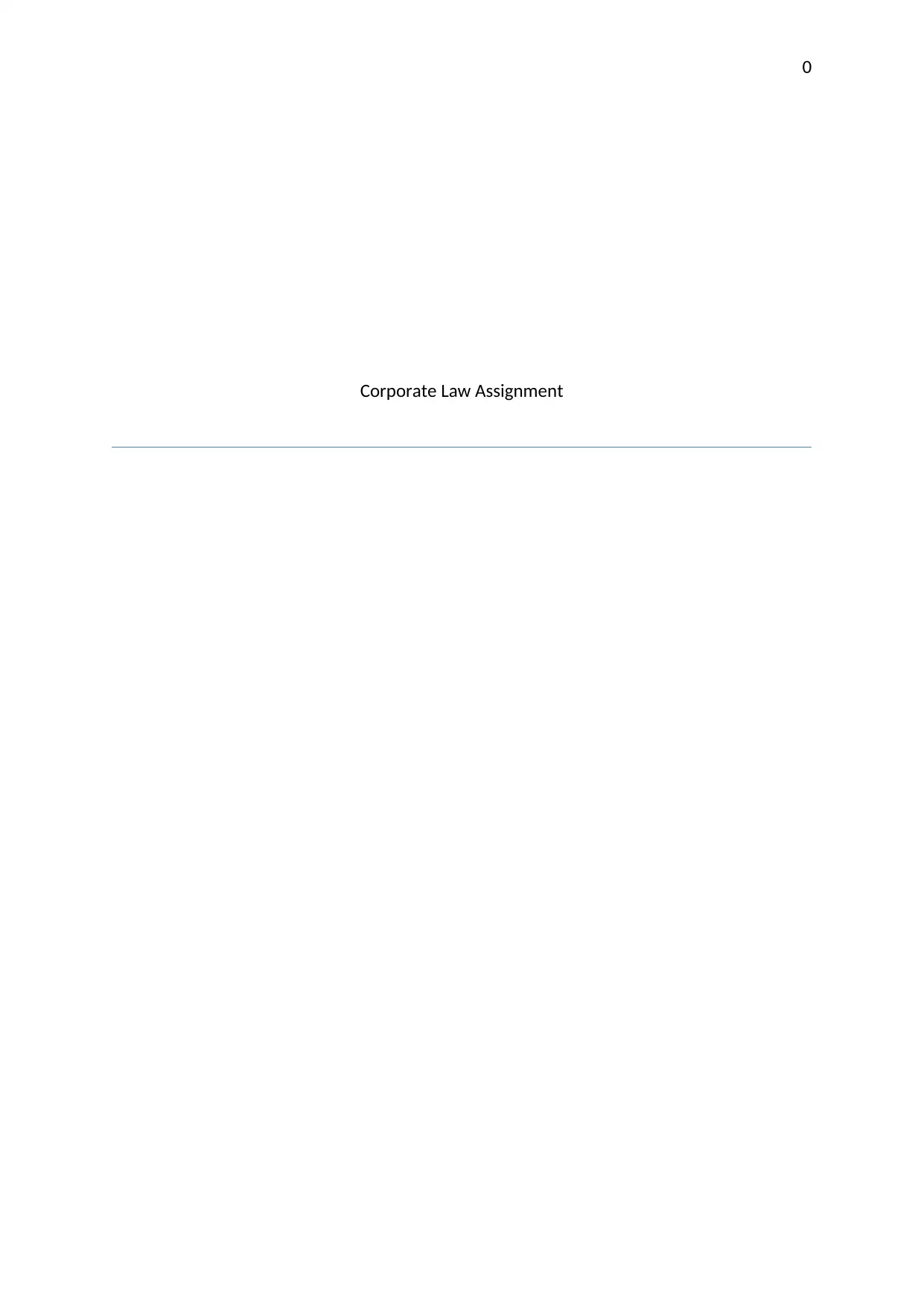
0
Corporate Law Assignment
Corporate Law Assignment
Paraphrase This Document
Need a fresh take? Get an instant paraphrase of this document with our AI Paraphraser
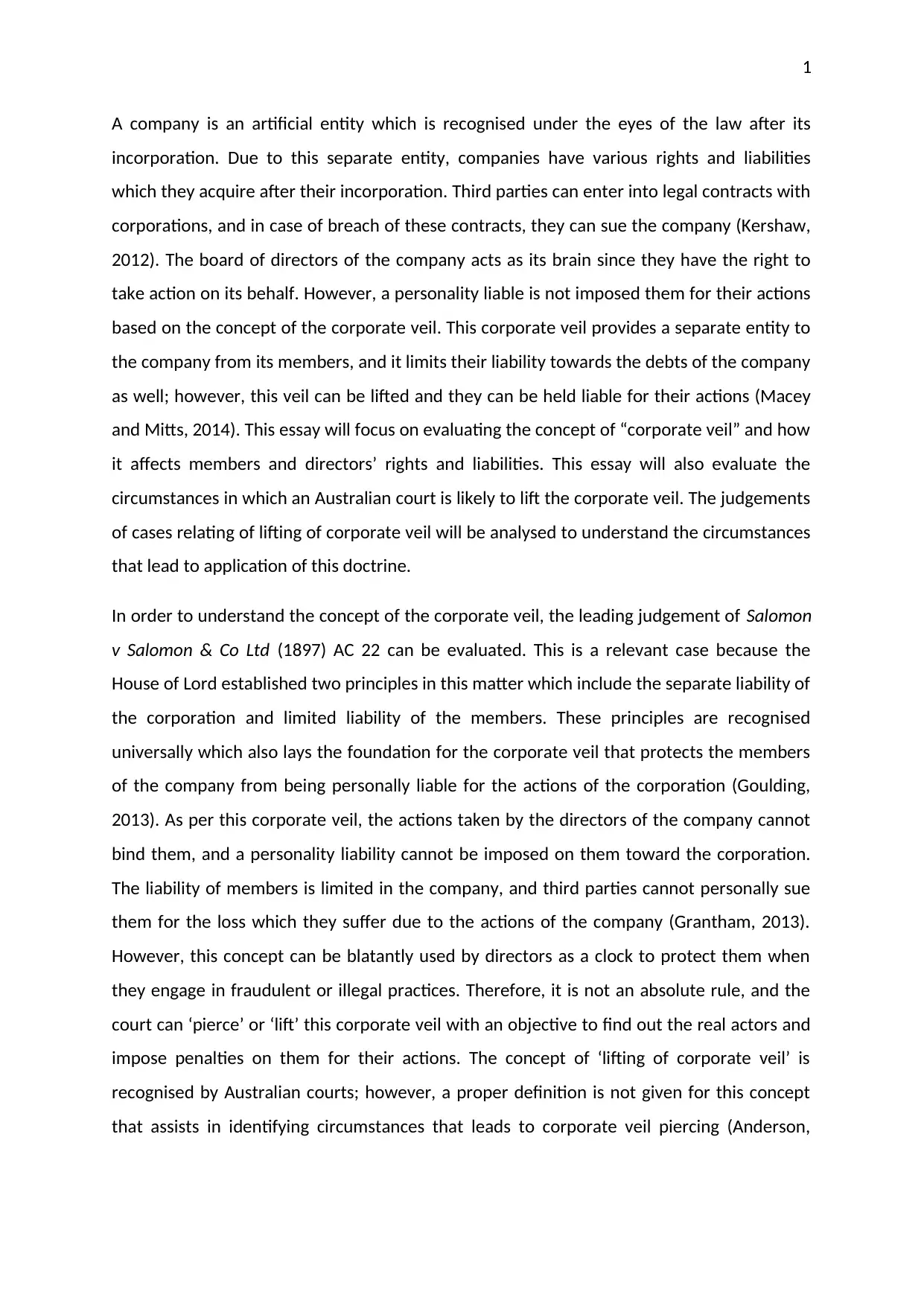
1
A company is an artificial entity which is recognised under the eyes of the law after its
incorporation. Due to this separate entity, companies have various rights and liabilities
which they acquire after their incorporation. Third parties can enter into legal contracts with
corporations, and in case of breach of these contracts, they can sue the company (Kershaw,
2012). The board of directors of the company acts as its brain since they have the right to
take action on its behalf. However, a personality liable is not imposed them for their actions
based on the concept of the corporate veil. This corporate veil provides a separate entity to
the company from its members, and it limits their liability towards the debts of the company
as well; however, this veil can be lifted and they can be held liable for their actions (Macey
and Mitts, 2014). This essay will focus on evaluating the concept of “corporate veil” and how
it affects members and directors’ rights and liabilities. This essay will also evaluate the
circumstances in which an Australian court is likely to lift the corporate veil. The judgements
of cases relating of lifting of corporate veil will be analysed to understand the circumstances
that lead to application of this doctrine.
In order to understand the concept of the corporate veil, the leading judgement of Salomon
v Salomon & Co Ltd (1897) AC 22 can be evaluated. This is a relevant case because the
House of Lord established two principles in this matter which include the separate liability of
the corporation and limited liability of the members. These principles are recognised
universally which also lays the foundation for the corporate veil that protects the members
of the company from being personally liable for the actions of the corporation (Goulding,
2013). As per this corporate veil, the actions taken by the directors of the company cannot
bind them, and a personality liability cannot be imposed on them toward the corporation.
The liability of members is limited in the company, and third parties cannot personally sue
them for the loss which they suffer due to the actions of the company (Grantham, 2013).
However, this concept can be blatantly used by directors as a clock to protect them when
they engage in fraudulent or illegal practices. Therefore, it is not an absolute rule, and the
court can ‘pierce’ or ‘lift’ this corporate veil with an objective to find out the real actors and
impose penalties on them for their actions. The concept of ‘lifting of corporate veil’ is
recognised by Australian courts; however, a proper definition is not given for this concept
that assists in identifying circumstances that leads to corporate veil piercing (Anderson,
A company is an artificial entity which is recognised under the eyes of the law after its
incorporation. Due to this separate entity, companies have various rights and liabilities
which they acquire after their incorporation. Third parties can enter into legal contracts with
corporations, and in case of breach of these contracts, they can sue the company (Kershaw,
2012). The board of directors of the company acts as its brain since they have the right to
take action on its behalf. However, a personality liable is not imposed them for their actions
based on the concept of the corporate veil. This corporate veil provides a separate entity to
the company from its members, and it limits their liability towards the debts of the company
as well; however, this veil can be lifted and they can be held liable for their actions (Macey
and Mitts, 2014). This essay will focus on evaluating the concept of “corporate veil” and how
it affects members and directors’ rights and liabilities. This essay will also evaluate the
circumstances in which an Australian court is likely to lift the corporate veil. The judgements
of cases relating of lifting of corporate veil will be analysed to understand the circumstances
that lead to application of this doctrine.
In order to understand the concept of the corporate veil, the leading judgement of Salomon
v Salomon & Co Ltd (1897) AC 22 can be evaluated. This is a relevant case because the
House of Lord established two principles in this matter which include the separate liability of
the corporation and limited liability of the members. These principles are recognised
universally which also lays the foundation for the corporate veil that protects the members
of the company from being personally liable for the actions of the corporation (Goulding,
2013). As per this corporate veil, the actions taken by the directors of the company cannot
bind them, and a personality liability cannot be imposed on them toward the corporation.
The liability of members is limited in the company, and third parties cannot personally sue
them for the loss which they suffer due to the actions of the company (Grantham, 2013).
However, this concept can be blatantly used by directors as a clock to protect them when
they engage in fraudulent or illegal practices. Therefore, it is not an absolute rule, and the
court can ‘pierce’ or ‘lift’ this corporate veil with an objective to find out the real actors and
impose penalties on them for their actions. The concept of ‘lifting of corporate veil’ is
recognised by Australian courts; however, a proper definition is not given for this concept
that assists in identifying circumstances that leads to corporate veil piercing (Anderson,
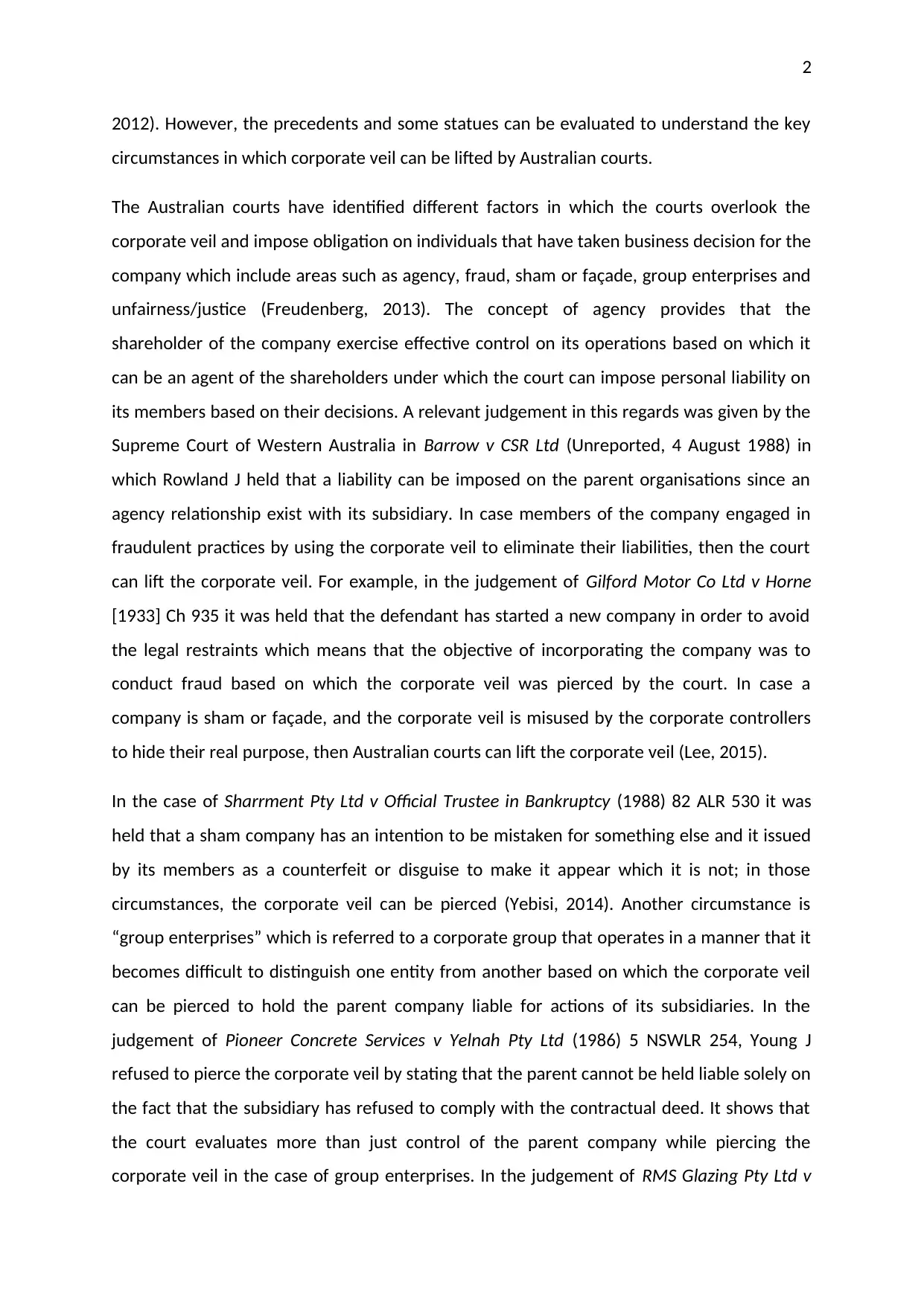
2
2012). However, the precedents and some statues can be evaluated to understand the key
circumstances in which corporate veil can be lifted by Australian courts.
The Australian courts have identified different factors in which the courts overlook the
corporate veil and impose obligation on individuals that have taken business decision for the
company which include areas such as agency, fraud, sham or façade, group enterprises and
unfairness/justice (Freudenberg, 2013). The concept of agency provides that the
shareholder of the company exercise effective control on its operations based on which it
can be an agent of the shareholders under which the court can impose personal liability on
its members based on their decisions. A relevant judgement in this regards was given by the
Supreme Court of Western Australia in Barrow v CSR Ltd (Unreported, 4 August 1988) in
which Rowland J held that a liability can be imposed on the parent organisations since an
agency relationship exist with its subsidiary. In case members of the company engaged in
fraudulent practices by using the corporate veil to eliminate their liabilities, then the court
can lift the corporate veil. For example, in the judgement of Gilford Motor Co Ltd v Horne
[1933] Ch 935 it was held that the defendant has started a new company in order to avoid
the legal restraints which means that the objective of incorporating the company was to
conduct fraud based on which the corporate veil was pierced by the court. In case a
company is sham or façade, and the corporate veil is misused by the corporate controllers
to hide their real purpose, then Australian courts can lift the corporate veil (Lee, 2015).
In the case of Sharrment Pty Ltd v Official Trustee in Bankruptcy (1988) 82 ALR 530 it was
held that a sham company has an intention to be mistaken for something else and it issued
by its members as a counterfeit or disguise to make it appear which it is not; in those
circumstances, the corporate veil can be pierced (Yebisi, 2014). Another circumstance is
“group enterprises” which is referred to a corporate group that operates in a manner that it
becomes difficult to distinguish one entity from another based on which the corporate veil
can be pierced to hold the parent company liable for actions of its subsidiaries. In the
judgement of Pioneer Concrete Services v Yelnah Pty Ltd (1986) 5 NSWLR 254, Young J
refused to pierce the corporate veil by stating that the parent cannot be held liable solely on
the fact that the subsidiary has refused to comply with the contractual deed. It shows that
the court evaluates more than just control of the parent company while piercing the
corporate veil in the case of group enterprises. In the judgement of RMS Glazing Pty Ltd v
2012). However, the precedents and some statues can be evaluated to understand the key
circumstances in which corporate veil can be lifted by Australian courts.
The Australian courts have identified different factors in which the courts overlook the
corporate veil and impose obligation on individuals that have taken business decision for the
company which include areas such as agency, fraud, sham or façade, group enterprises and
unfairness/justice (Freudenberg, 2013). The concept of agency provides that the
shareholder of the company exercise effective control on its operations based on which it
can be an agent of the shareholders under which the court can impose personal liability on
its members based on their decisions. A relevant judgement in this regards was given by the
Supreme Court of Western Australia in Barrow v CSR Ltd (Unreported, 4 August 1988) in
which Rowland J held that a liability can be imposed on the parent organisations since an
agency relationship exist with its subsidiary. In case members of the company engaged in
fraudulent practices by using the corporate veil to eliminate their liabilities, then the court
can lift the corporate veil. For example, in the judgement of Gilford Motor Co Ltd v Horne
[1933] Ch 935 it was held that the defendant has started a new company in order to avoid
the legal restraints which means that the objective of incorporating the company was to
conduct fraud based on which the corporate veil was pierced by the court. In case a
company is sham or façade, and the corporate veil is misused by the corporate controllers
to hide their real purpose, then Australian courts can lift the corporate veil (Lee, 2015).
In the case of Sharrment Pty Ltd v Official Trustee in Bankruptcy (1988) 82 ALR 530 it was
held that a sham company has an intention to be mistaken for something else and it issued
by its members as a counterfeit or disguise to make it appear which it is not; in those
circumstances, the corporate veil can be pierced (Yebisi, 2014). Another circumstance is
“group enterprises” which is referred to a corporate group that operates in a manner that it
becomes difficult to distinguish one entity from another based on which the corporate veil
can be pierced to hold the parent company liable for actions of its subsidiaries. In the
judgement of Pioneer Concrete Services v Yelnah Pty Ltd (1986) 5 NSWLR 254, Young J
refused to pierce the corporate veil by stating that the parent cannot be held liable solely on
the fact that the subsidiary has refused to comply with the contractual deed. It shows that
the court evaluates more than just control of the parent company while piercing the
corporate veil in the case of group enterprises. In the judgement of RMS Glazing Pty Ltd v
⊘ This is a preview!⊘
Do you want full access?
Subscribe today to unlock all pages.

Trusted by 1+ million students worldwide
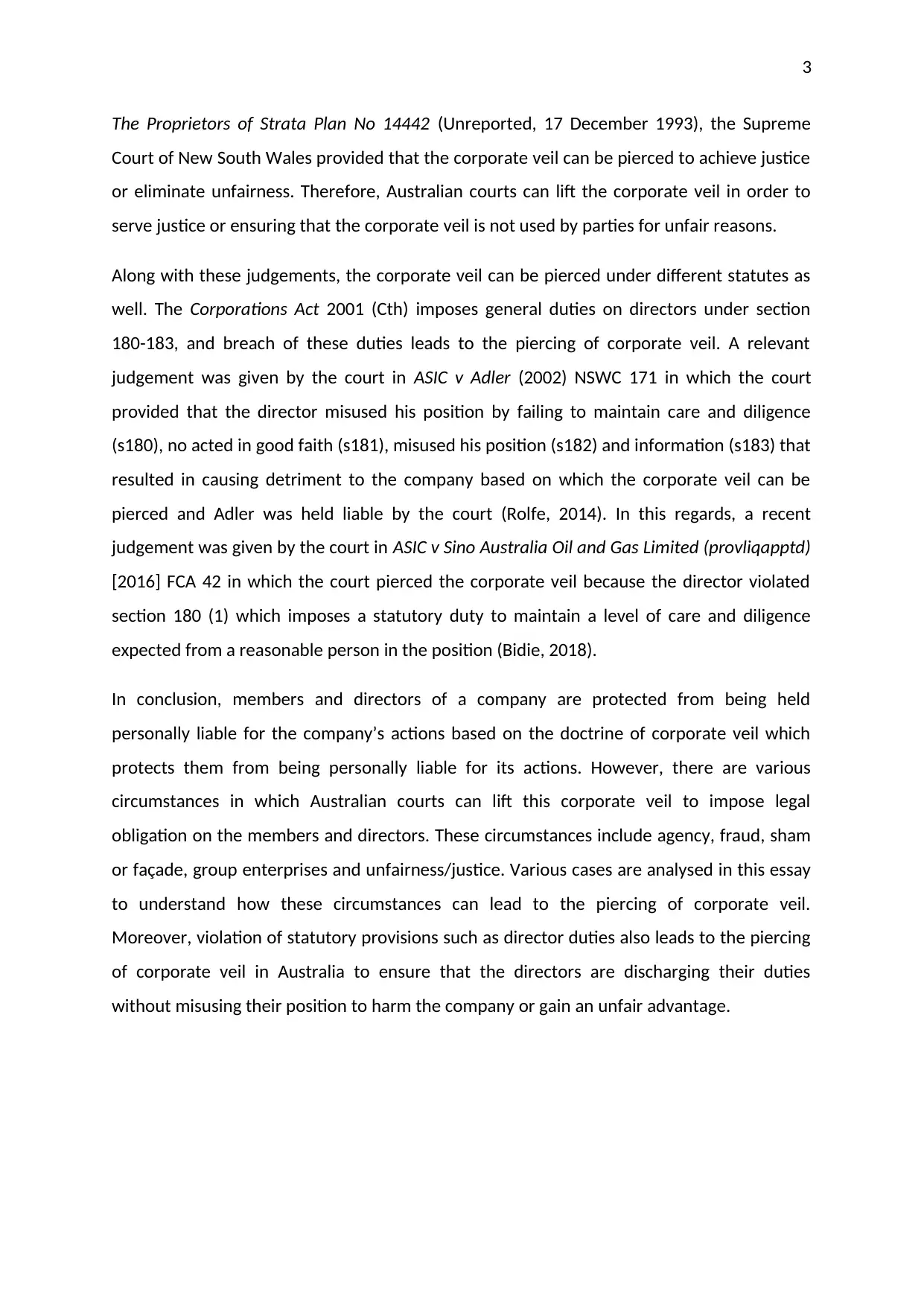
3
The Proprietors of Strata Plan No 14442 (Unreported, 17 December 1993), the Supreme
Court of New South Wales provided that the corporate veil can be pierced to achieve justice
or eliminate unfairness. Therefore, Australian courts can lift the corporate veil in order to
serve justice or ensuring that the corporate veil is not used by parties for unfair reasons.
Along with these judgements, the corporate veil can be pierced under different statutes as
well. The Corporations Act 2001 (Cth) imposes general duties on directors under section
180-183, and breach of these duties leads to the piercing of corporate veil. A relevant
judgement was given by the court in ASIC v Adler (2002) NSWC 171 in which the court
provided that the director misused his position by failing to maintain care and diligence
(s180), no acted in good faith (s181), misused his position (s182) and information (s183) that
resulted in causing detriment to the company based on which the corporate veil can be
pierced and Adler was held liable by the court (Rolfe, 2014). In this regards, a recent
judgement was given by the court in ASIC v Sino Australia Oil and Gas Limited (provliqapptd)
[2016] FCA 42 in which the court pierced the corporate veil because the director violated
section 180 (1) which imposes a statutory duty to maintain a level of care and diligence
expected from a reasonable person in the position (Bidie, 2018).
In conclusion, members and directors of a company are protected from being held
personally liable for the company’s actions based on the doctrine of corporate veil which
protects them from being personally liable for its actions. However, there are various
circumstances in which Australian courts can lift this corporate veil to impose legal
obligation on the members and directors. These circumstances include agency, fraud, sham
or façade, group enterprises and unfairness/justice. Various cases are analysed in this essay
to understand how these circumstances can lead to the piercing of corporate veil.
Moreover, violation of statutory provisions such as director duties also leads to the piercing
of corporate veil in Australia to ensure that the directors are discharging their duties
without misusing their position to harm the company or gain an unfair advantage.
The Proprietors of Strata Plan No 14442 (Unreported, 17 December 1993), the Supreme
Court of New South Wales provided that the corporate veil can be pierced to achieve justice
or eliminate unfairness. Therefore, Australian courts can lift the corporate veil in order to
serve justice or ensuring that the corporate veil is not used by parties for unfair reasons.
Along with these judgements, the corporate veil can be pierced under different statutes as
well. The Corporations Act 2001 (Cth) imposes general duties on directors under section
180-183, and breach of these duties leads to the piercing of corporate veil. A relevant
judgement was given by the court in ASIC v Adler (2002) NSWC 171 in which the court
provided that the director misused his position by failing to maintain care and diligence
(s180), no acted in good faith (s181), misused his position (s182) and information (s183) that
resulted in causing detriment to the company based on which the corporate veil can be
pierced and Adler was held liable by the court (Rolfe, 2014). In this regards, a recent
judgement was given by the court in ASIC v Sino Australia Oil and Gas Limited (provliqapptd)
[2016] FCA 42 in which the court pierced the corporate veil because the director violated
section 180 (1) which imposes a statutory duty to maintain a level of care and diligence
expected from a reasonable person in the position (Bidie, 2018).
In conclusion, members and directors of a company are protected from being held
personally liable for the company’s actions based on the doctrine of corporate veil which
protects them from being personally liable for its actions. However, there are various
circumstances in which Australian courts can lift this corporate veil to impose legal
obligation on the members and directors. These circumstances include agency, fraud, sham
or façade, group enterprises and unfairness/justice. Various cases are analysed in this essay
to understand how these circumstances can lead to the piercing of corporate veil.
Moreover, violation of statutory provisions such as director duties also leads to the piercing
of corporate veil in Australia to ensure that the directors are discharging their duties
without misusing their position to harm the company or gain an unfair advantage.
Paraphrase This Document
Need a fresh take? Get an instant paraphrase of this document with our AI Paraphraser
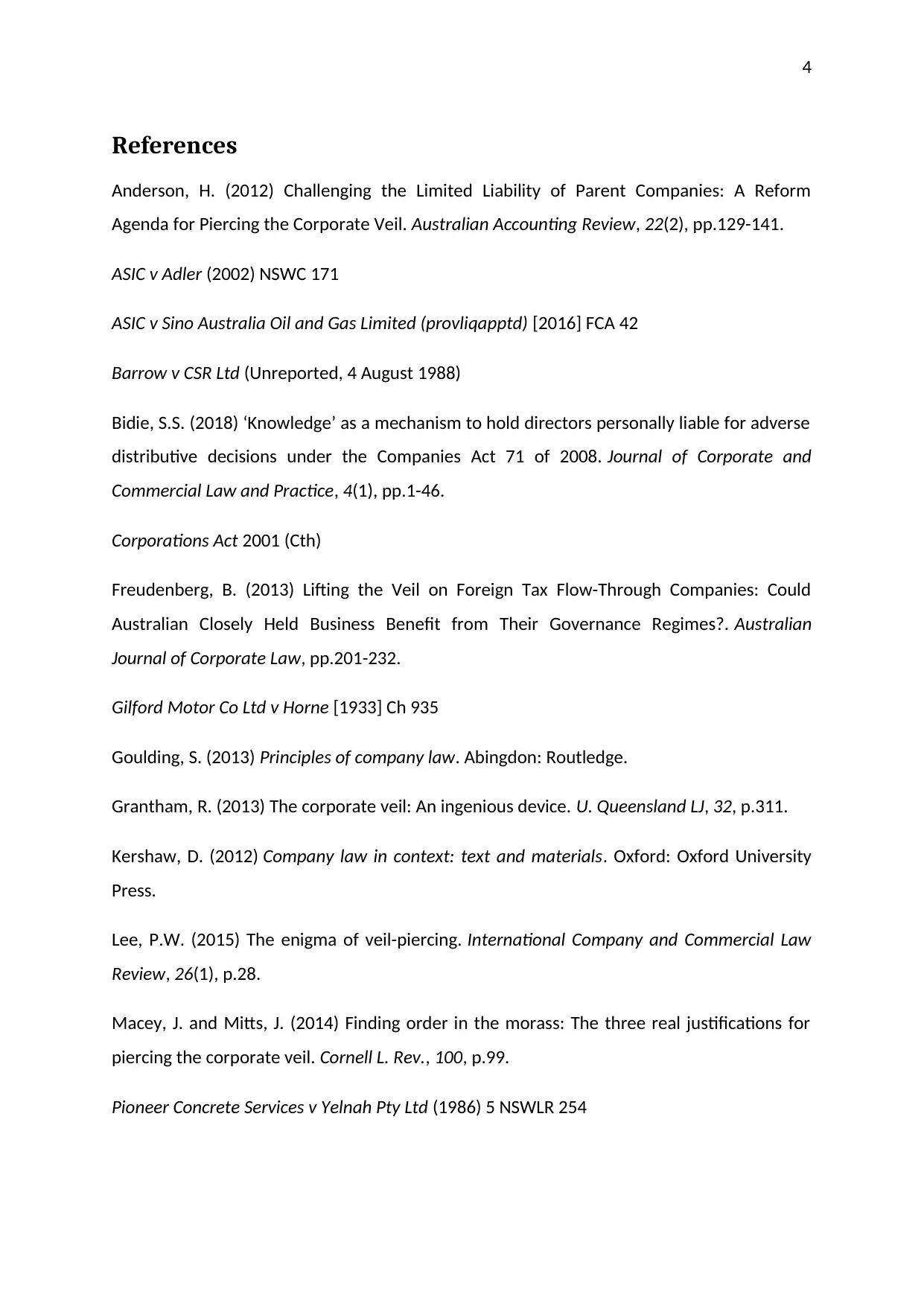
4
References
Anderson, H. (2012) Challenging the Limited Liability of Parent Companies: A Reform
Agenda for Piercing the Corporate Veil. Australian Accounting Review, 22(2), pp.129-141.
ASIC v Adler (2002) NSWC 171
ASIC v Sino Australia Oil and Gas Limited (provliqapptd) [2016] FCA 42
Barrow v CSR Ltd (Unreported, 4 August 1988)
Bidie, S.S. (2018) ‘Knowledge’ as a mechanism to hold directors personally liable for adverse
distributive decisions under the Companies Act 71 of 2008. Journal of Corporate and
Commercial Law and Practice, 4(1), pp.1-46.
Corporations Act 2001 (Cth)
Freudenberg, B. (2013) Lifting the Veil on Foreign Tax Flow-Through Companies: Could
Australian Closely Held Business Benefit from Their Governance Regimes?. Australian
Journal of Corporate Law, pp.201-232.
Gilford Motor Co Ltd v Horne [1933] Ch 935
Goulding, S. (2013) Principles of company law. Abingdon: Routledge.
Grantham, R. (2013) The corporate veil: An ingenious device. U. Queensland LJ, 32, p.311.
Kershaw, D. (2012) Company law in context: text and materials. Oxford: Oxford University
Press.
Lee, P.W. (2015) The enigma of veil-piercing. International Company and Commercial Law
Review, 26(1), p.28.
Macey, J. and Mitts, J. (2014) Finding order in the morass: The three real justifications for
piercing the corporate veil. Cornell L. Rev., 100, p.99.
Pioneer Concrete Services v Yelnah Pty Ltd (1986) 5 NSWLR 254
References
Anderson, H. (2012) Challenging the Limited Liability of Parent Companies: A Reform
Agenda for Piercing the Corporate Veil. Australian Accounting Review, 22(2), pp.129-141.
ASIC v Adler (2002) NSWC 171
ASIC v Sino Australia Oil and Gas Limited (provliqapptd) [2016] FCA 42
Barrow v CSR Ltd (Unreported, 4 August 1988)
Bidie, S.S. (2018) ‘Knowledge’ as a mechanism to hold directors personally liable for adverse
distributive decisions under the Companies Act 71 of 2008. Journal of Corporate and
Commercial Law and Practice, 4(1), pp.1-46.
Corporations Act 2001 (Cth)
Freudenberg, B. (2013) Lifting the Veil on Foreign Tax Flow-Through Companies: Could
Australian Closely Held Business Benefit from Their Governance Regimes?. Australian
Journal of Corporate Law, pp.201-232.
Gilford Motor Co Ltd v Horne [1933] Ch 935
Goulding, S. (2013) Principles of company law. Abingdon: Routledge.
Grantham, R. (2013) The corporate veil: An ingenious device. U. Queensland LJ, 32, p.311.
Kershaw, D. (2012) Company law in context: text and materials. Oxford: Oxford University
Press.
Lee, P.W. (2015) The enigma of veil-piercing. International Company and Commercial Law
Review, 26(1), p.28.
Macey, J. and Mitts, J. (2014) Finding order in the morass: The three real justifications for
piercing the corporate veil. Cornell L. Rev., 100, p.99.
Pioneer Concrete Services v Yelnah Pty Ltd (1986) 5 NSWLR 254
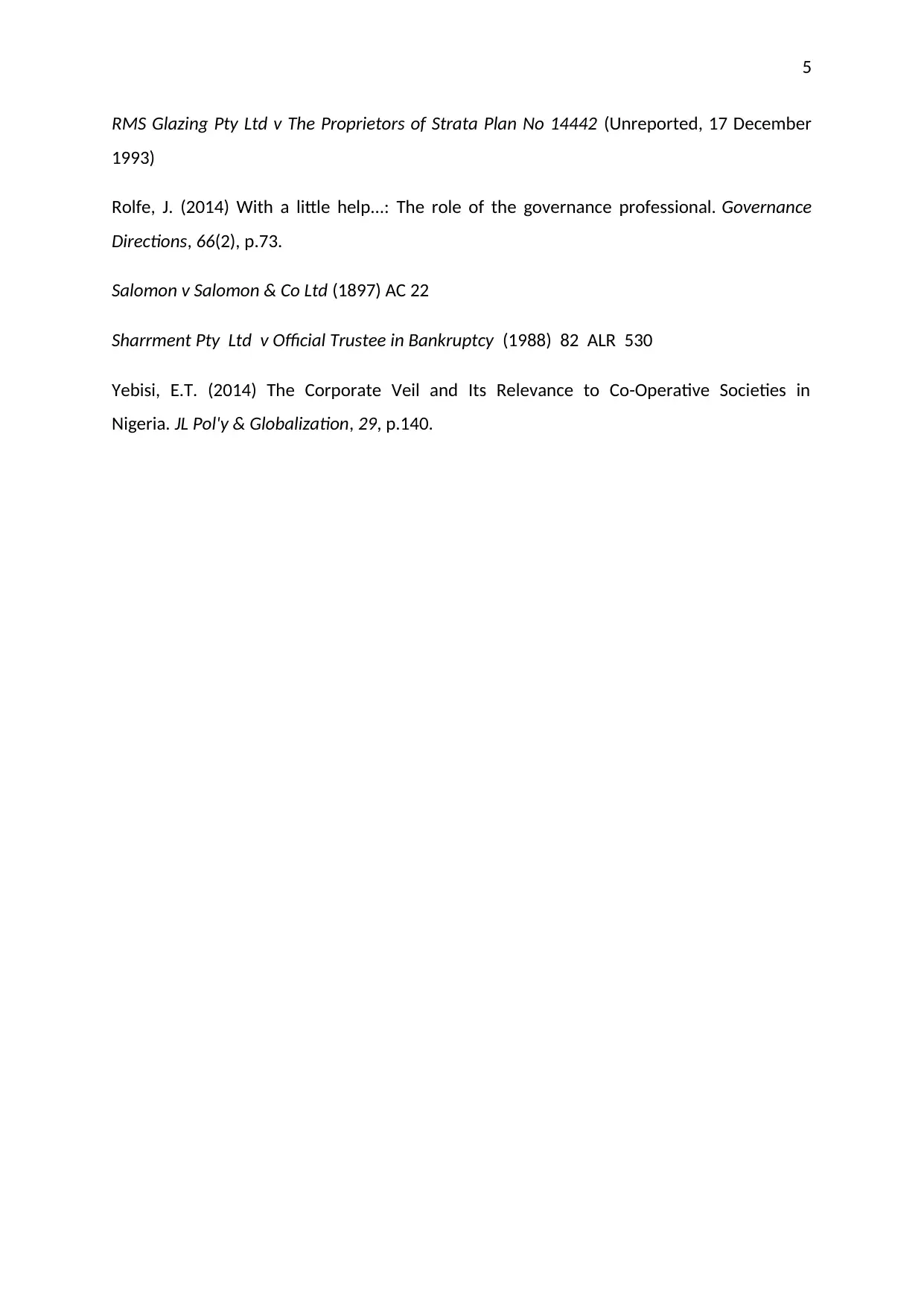
5
RMS Glazing Pty Ltd v The Proprietors of Strata Plan No 14442 (Unreported, 17 December
1993)
Rolfe, J. (2014) With a little help...: The role of the governance professional. Governance
Directions, 66(2), p.73.
Salomon v Salomon & Co Ltd (1897) AC 22
Sharrment Pty Ltd v Official Trustee in Bankruptcy (1988) 82 ALR 530
Yebisi, E.T. (2014) The Corporate Veil and Its Relevance to Co-Operative Societies in
Nigeria. JL Pol'y & Globalization, 29, p.140.
RMS Glazing Pty Ltd v The Proprietors of Strata Plan No 14442 (Unreported, 17 December
1993)
Rolfe, J. (2014) With a little help...: The role of the governance professional. Governance
Directions, 66(2), p.73.
Salomon v Salomon & Co Ltd (1897) AC 22
Sharrment Pty Ltd v Official Trustee in Bankruptcy (1988) 82 ALR 530
Yebisi, E.T. (2014) The Corporate Veil and Its Relevance to Co-Operative Societies in
Nigeria. JL Pol'y & Globalization, 29, p.140.
⊘ This is a preview!⊘
Do you want full access?
Subscribe today to unlock all pages.

Trusted by 1+ million students worldwide
1 out of 6
Related Documents
Your All-in-One AI-Powered Toolkit for Academic Success.
+13062052269
info@desklib.com
Available 24*7 on WhatsApp / Email
![[object Object]](/_next/static/media/star-bottom.7253800d.svg)
Unlock your academic potential
Copyright © 2020–2025 A2Z Services. All Rights Reserved. Developed and managed by ZUCOL.





